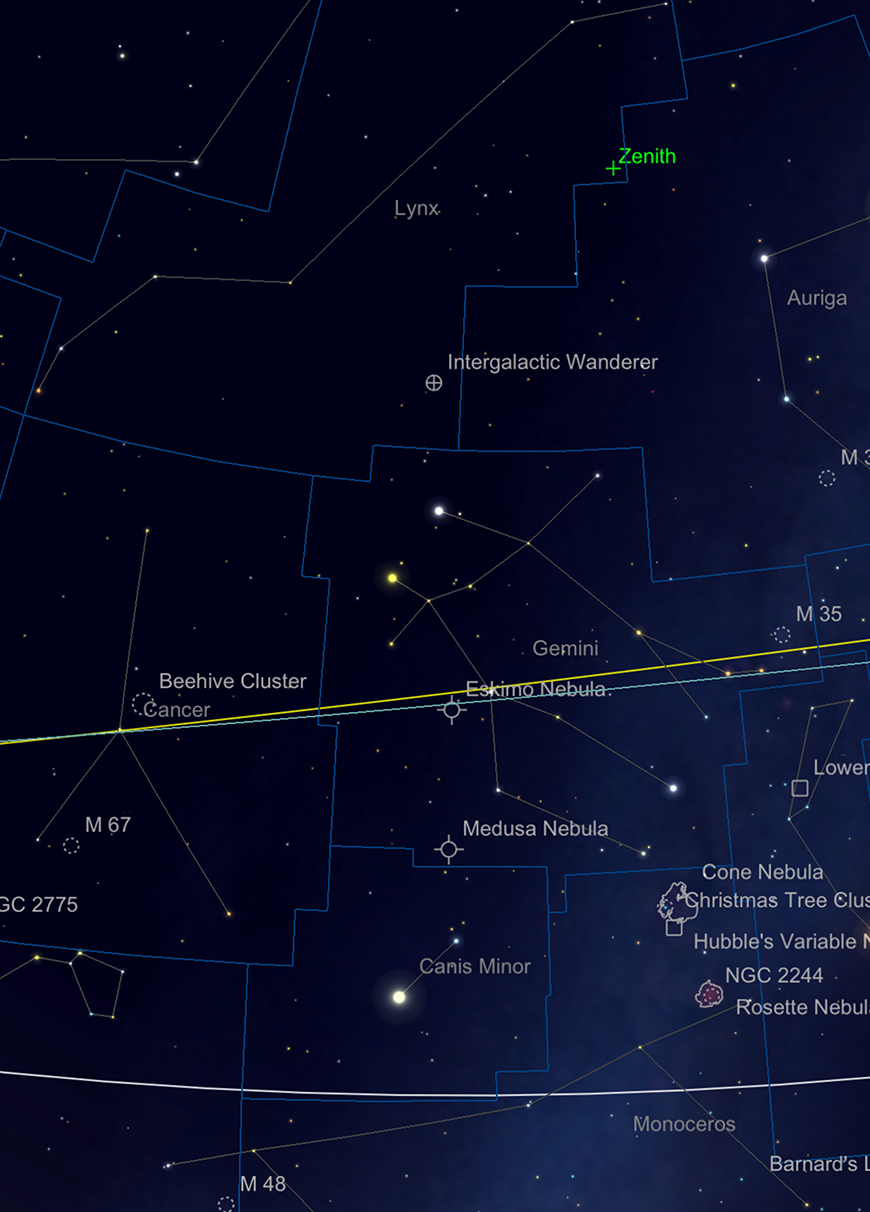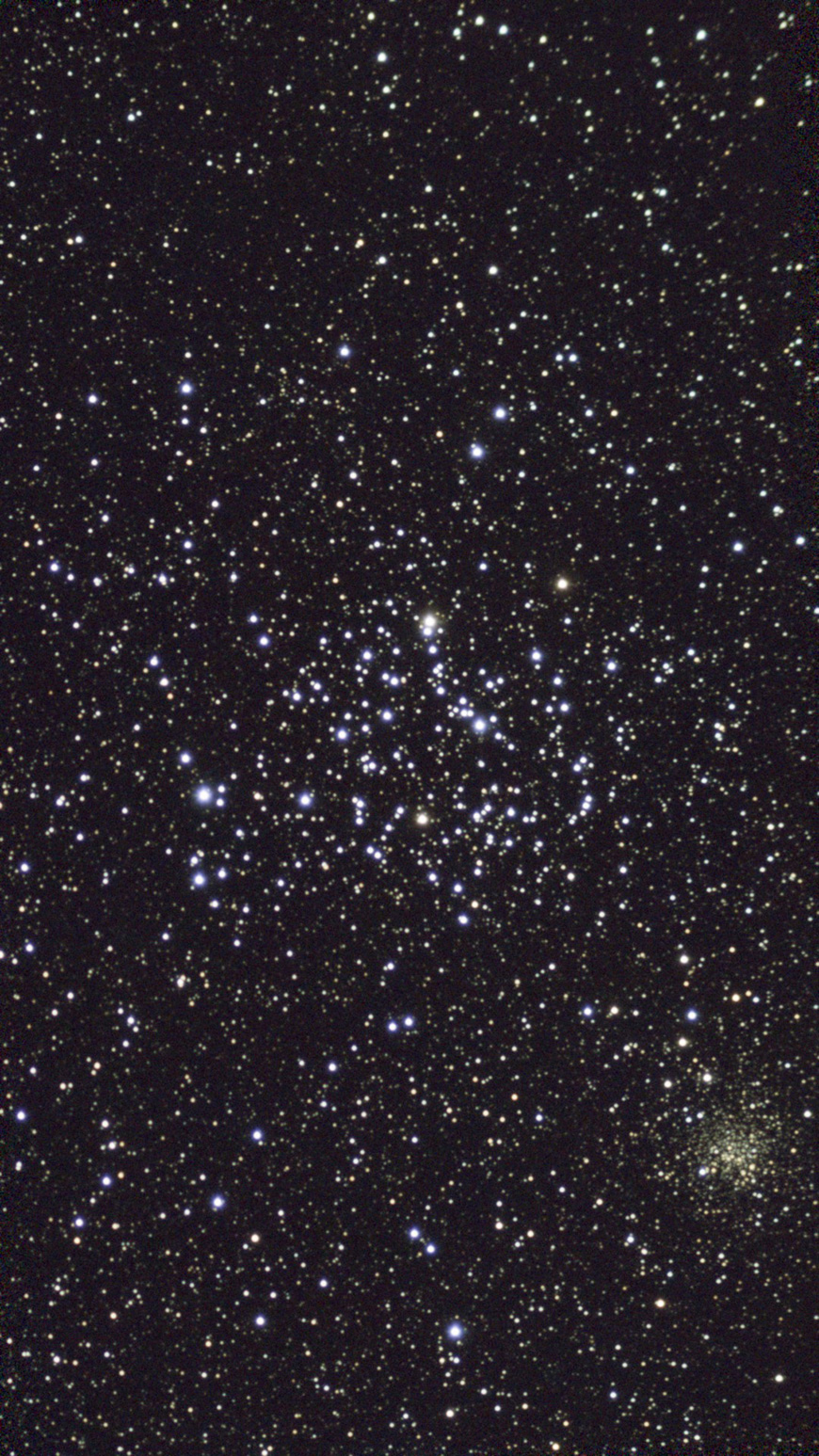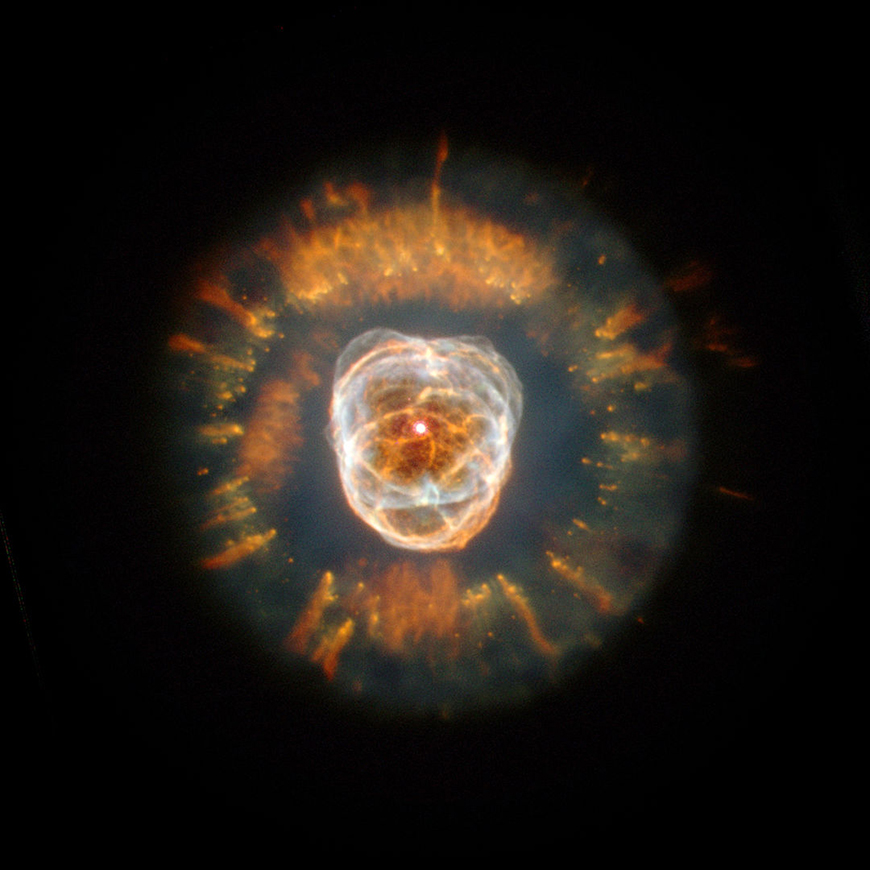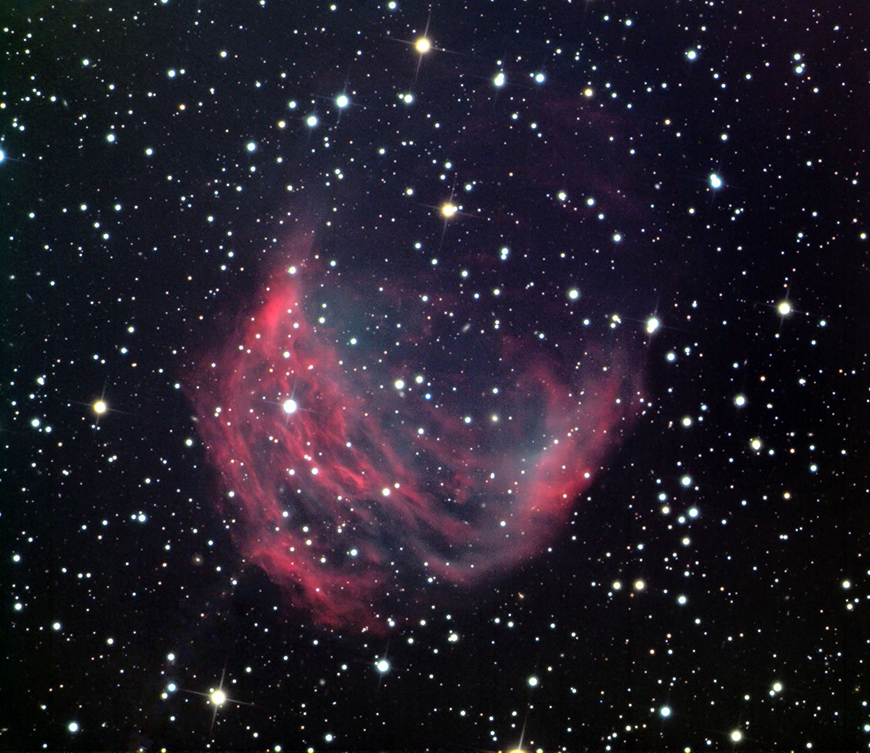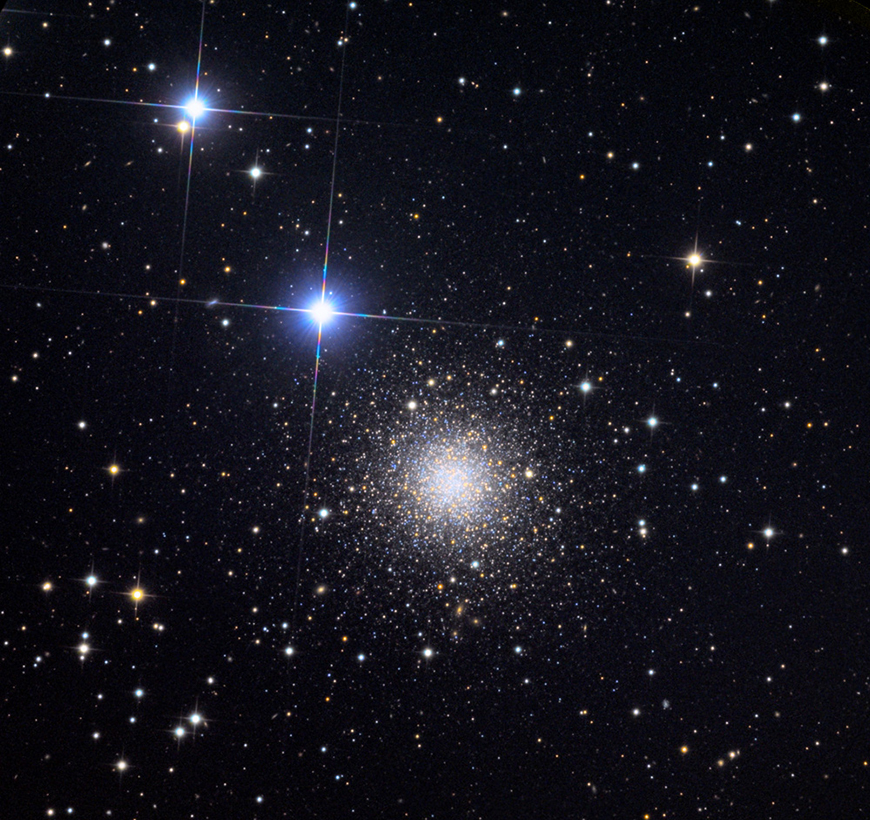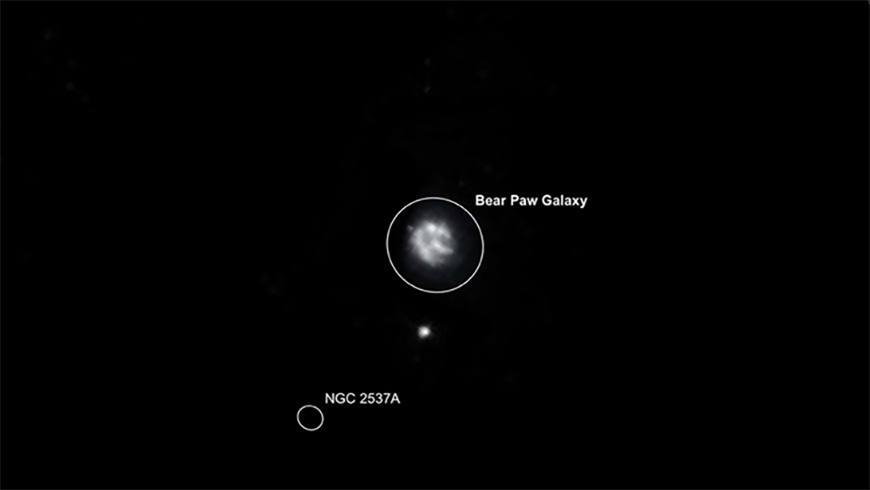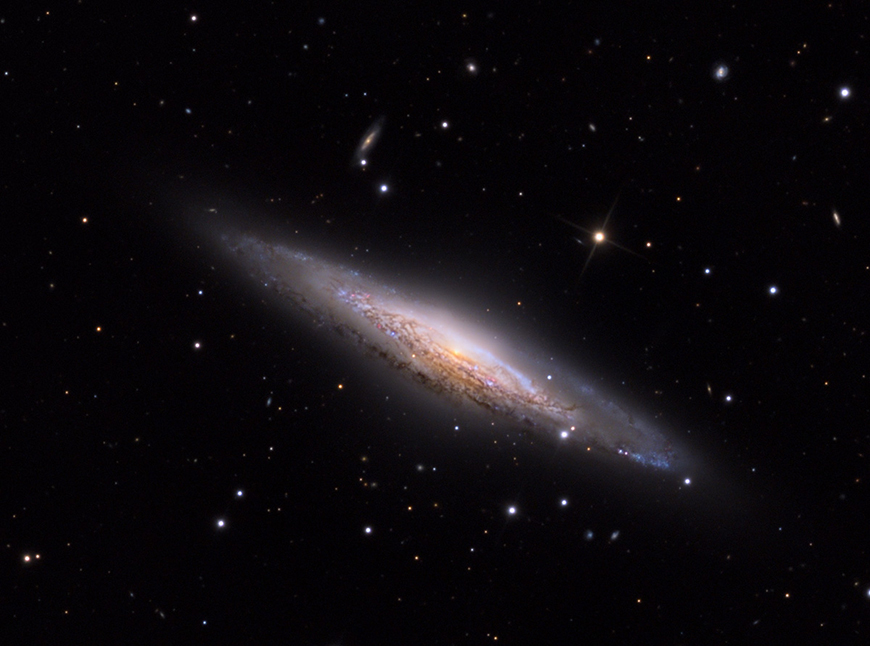Deep Sky Delights in Canis Minor, Gemini and Lynx
Canis Minor, the Little Dog, is a compact constellation, notable for its bright star Procyon, which at +0.34 magnitude, is the 8th brightest star in the sky. Procyon is notable as one of the nearest stars to our own solar system, sitting some 11.4 light years away - making it our14th closest stellar neighbour. Procyon is a binary star, whose constituents are the main A star - a white main sequence star of spectral type F5 - and a companion, B - which is a white dwarf (type DA). This companion is a very difficult star to observe, but perturbations in observations of A's proper motion gave it away in 1840 - and by 1861 its orbit had been worked out, yet visual confirmation of B had to wait until a little later. Procyon B was finally observed in 1896 by the Lick 36-Inch Refractor. It remains a very difficult object to observe, even in large telescopes, as its angular separation with the primary star is so small. This and the difference in brightness (+0.4 mag for A +10.8 mag for B), mean it is rarely seen and requires exceptional conditions to even attempt. The two stars are currently separated by 3.9 arc seconds, which roughly approximates to 15 AU actual separation - roughly the distance from the Sun to Uranus.
Procyon is a compound of the Greek for "preceding the dog" - the root meaning of this name comes from the fact that this star was observed to rise just before Sirius, in Canis Major and had great significance to ancient observers because of this. Ancient Arab myth saw the two main stars of both constellations as sisters, the elder of which, Sirius kept over the "river" of the Milky Way, which now runs between them. The younger of the Sisters, Procyon, was afraid and stayed on the original bank and wept. It was these tears that fed the celestial river of the Milky Way and eventually drained into the Nile, causing it to flood. The reappearance of both stars rising in the evening each year precedes this event - and thus the legend was born. Indeed, Beta Canis Minor, to be found to the NW of Procyon is named Gomeisa, which translates from the Arabic "little teary (or bleary) eyed one" - a literal link to this legend
Moving northward into Gemini, we come to the twin stars of Castor and Pollux, Alpha and Beta Geminorum, respectively. Pollux, the Beta star is actually brighter than Castor, the Alpha - and while it has been suggested that when Bayer codified the brightness classification of stars in the 17th century, Castor was the brighter of the two, this is extremely unlikely.
Castor is a fine double star and an easy target in small instruments. Consisting of two stars, A and B, of +2 and +2.9 mag respectively, Castor's elements are currently widening and are separated by 4.5-5 seconds of arc. Castor's double nature was discovered in 1678 by Cassini (he of Saturn's ring division fame, amongst many other discoveries) and bears the distinction of being the first gravitationally bound object to be identified beyond the reaches of the Solar System. Castor A and B's orbit about a mutual gravitational point takes around 467 years to complete, but both stars are also in turn doubles, with much fainter M-class dwarf companions. In addition to these companions there is also present in the system a further pair of gravitationally bound M-class stars. This makes Castor not just a double star, but a sextuple - quite a collection! Sadly, only the primary elements are observable in amateur instruments.
To the westerly reaches of Gemini, is to be found M35. M35 is a very prominent star cluster, at +5 mag, easily picked in small telescopes and binoculars and can also be seen with the naked eye from a reasonable site. Consisting of well in excess of 100 observable stars (mags 6-13th), M35 was first noted by Astronomer Philippe Loys de Cheseaux in 1745. Also included in the Uranographica Britannica by John Bevis in 1750, M35 was catalogued by Messier in 1764, who credited Bevis with its discovery.
Many of the 100+ observable stars are types G and K stars - similar in class to our Sun - though these seem to be of a considerably larger mean size than main sequence. M35 is tentatively aged at about 100 million years - about the age of the nearby M45, (the Pleiades) - though problematically, stellar evolution is thought to be considerably more advanced in the case of M35. Does this mean that M35 is in fact older, or are the Pleiades actually younger? Further observation and theories will be needed to explain this anomaly.
In the background sky to M35 lies the fainter (+8 mag) open cluster NGC2158, though this is nearly six times further away than M35's 2800 light years. In addition to this, there is also the yet fainter and more compact IC2157 cluster (+8.4 mag) - making this an extremely rich area for sweeping with virtually any type of optical aid.
Drifting eastward, 2 1/3 degrees east of the star Wasat (Delta Geminorum) is the fabulous Eskimo Nebula, NGC2392. This Planetary Nebula supposedly resembles an Eskimo's head, surrounded by the fur of an Arctic Parka hood. A reasonably compact 0.8 arc minute across (about 2/3rds the size of the Ring Nebula, M57), the Eskimo is only +9.19 mag, though its compact size makes its surface brightness quite high and it takes magnification well. Discovered by William Herschel in 1787, it is perhaps surprising that it wasn't noticed by earlier observers - though this is most likely down to its small size. OIII filters reveal more of the two stages of the object: its tenuous outer shell and the gleaming, brighter interior. Larger instruments reveal more of the complex structure of the internal part of the Eskimo - its radial double shell of expanding gasses and fine dust blown by cosmic winds form its central star. This central star shines at +10.5 mag and is relatively easy to spot in most instruments. The nebula is thought to lie at 2800-3000 light years distance.
Further south from the Eskimo is another older, larger and fainter object - The Medusa Nebula (Abel 21). Whereas the Eskimo is small and comparatively bright, the Medusa is large - at 10 arc minutes across it is a third the diameter of the Full Moon. Telescopes of 8-inches + aperture, coupled with a good OIII filter and a dark site will be needed to see the Medusa. Although listed as being +10.19 mag, this is spread out over a significant area of sky, so it is in long duration astrophotography that the wonders of the Medusa really start to reveal themselves. A modest aperture telescope will be needed and a sturdy equatorial mount, capable of being autoguided, will be needed to attempt to image this object. Images reveal the serpent-like tendrils of nebulosity that give this mysterious object its name - its namesake Medusa being the Gorgon who had snakes for hair in classical Greek mythology. The stare of Medusa was reputed to turn people to stone, though staring at this nebula through a large telescope will be a much more pleasant experience… The Medusa lies about half the distance from us as the Eskimo Nebula - 1500 light years and is around 4 light years in diameter. Opinions were divided on the true nature of the Medusa: George Abel, its discoverer thought it to be an old planetary nebula, whereas many considered its irregular nature to indicate it was a supernova remnant. Narrowband imaging has revealed the true extent of the Medusa's helical hourglass figure - making it much more likely to be, as Abel initially suggested, a planetary nebula.
Drifting northward, we come to the large, sparce constellation of Lynx, which contains a couple of interesting objects for Deep Sky enthusiasts.
The first object of note is NGC2419, the Intergalactic Wanderer, a rather dim globular cluster, which lies some way away from the regular haunt of the globular - the shell around the central part of the Milky Way. The Intergalactic Wanderer was nicknamed as such, due to the fact it used to be thought as an extra-galactic cluster, wandering through space. Observations of its motion have revealed it is not - it is indeed a satellite of our galaxy, much as the other major globulars are - in NGC2419's case, just a very outlying one. At 270,000-300,000 light years from us, it is almost twice as distant as the Large Magellanic Cloud, but intrinsically very luminous. It almost matches the King of Globular clusters, Omega Centauri, for true brightness, but appears as a rather feeble +10 mag object at just 1.8 arc minutes across, simply because it is so far away. Larger telescopes will be needed to see much of it, though it is possible to pick out in smaller instruments from dark locations.
Lynx, whilst obscure to the naked eye observer, also contains a couple of galaxies of note, NGC2537, otherwise known as the Bear Paw Galaxy and NGC2683, The UFO Galaxy.
The Bear Paw is a barred spiral is located roughly in the centre of Lynx, 9 1/2 degrees to the north of the Intergalactic Wanderer and some 14 3/4 degrees to the NW of NGC2683 - giving a good idea how large Lynx is as a constellation. The Bear Paw is a very compact object, being some 1.7 x1.5 minutes of arc across - and although officially classed as a +11.69 mag object has a high surface brightness because of its diminutive area and is rather more visible than many objects of similar listed magnitude. The Bear Paw is so-called due to the areas of brightness which form a patchy pattern, which somewhat resemble the paw print of an animal. Whether it is that of a Bear or not, we leave you to draw your own conclusions... NGC2537 is thought to lie some 22 million light years away from our own Milky Way Galaxy.
Discovered in 1788 by William Herschel, NGC2683, otherwise known as the UFO Galaxy (for obvious reasons), is a spectacular object which lies almost edge on to our line of sight on Earth and subsequently has a very reasonable surface brightness. Covering an area of sky 9.3 x 2.1 arc minutes, NGC2683 is easily seen in large telescopes, whereas smaller scopes will just resolve its bright elongated core. The foreshortened spiral arms of the UFO galaxy are laced with dust lanes, one of the major examples of this practically bisects the core from our perspective.
It is thought that NGC2683 is reasonably close to the Milky Way group, from a cosmic perspective, though different sources list its distance as a widely variable 16-33 million light years away. The UFO Galaxy's core is often remarked upon as appearing yellow - indeed, it seems that there are a larger population of older yellow and red stars in this galaxy than average and that there is little star-forming activity taking place within the system. Compared to our galaxy, though less massive and luminous, NGC2683 boasts twice the number of globular clusters.
Text: Kerin Smith

 English
English
